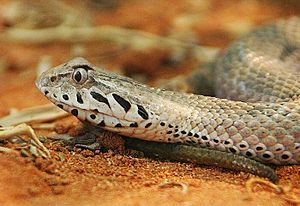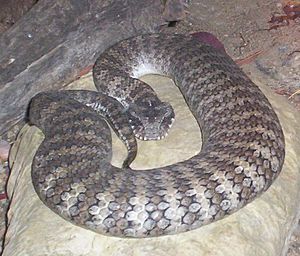Acanthophis facts for kids
Quick facts for kids Acanthophis |
|
|---|---|
 |
|
| Acanthophis laevis | |
| Scientific classification | |
| Species | |
|
See taxonomy |
Acanthophis is a group of snakes often called death adders. These snakes live in Australia, New Guinea, and nearby islands. They are known for being among the most venomous snakes in the world. The name Acanthophis comes from Ancient Greek words: akanthos (meaning 'spine') and ophis (meaning 'snake'). This name refers to the small spine found on the end of a death adder's tail.
Scientists have identified seven different types, or species, of death adders. However, it's still a bit unclear exactly how many species belong to this group. Some experts think there could be anywhere from 4 to 15 different kinds!
Contents
What are Death Adders?
Death adders belong to the elapid family of snakes. This means they are related to cobras, mambas, and coral snakes. Even though they look a lot like vipers (another type of snake), they are not actually related to them. Their similar appearance is a cool example of convergent evolution. This is when different animals develop similar features because they live in similar ways.
How Death Adders Look
Death adders have a unique look. They have short, strong bodies and heads shaped like a triangle. Their eyes have vertical pupils, which are the dark centers of the eye. They also have many small scales on top of their heads.
Their fangs are longer and can move more than those of most other elapid snakes. However, they are not as big as the fangs of true vipers.
Death adders usually take about 2 to 3 years to grow to their full adult size. Female death adders are generally a little bit bigger than males.
Special Tail Lure
One of the easiest ways to tell a death adder apart from other Australian snakes is its tail. They have a small, worm-like lure on the end of their tail. They use this lure to attract prey, like a fishing rod!
Their bodies often have wide bands of color. The exact colors can change depending on where they live. You might see them in black, grey, red, yellow, brown, or even greenish-grey.
Why are They Called Death Adders?
When early settlers came to Australia, they first called these snakes 'deaf adders'. This was because, unlike most other snakes that quickly slither away when people come near, death adders tend to stay still. People thought this meant the snakes couldn't hear them.
However, death adders, like all snakes, can feel vibrations in the ground. So, they aren't actually deaf. They just have a different way of reacting to danger.
How Death Adders Hunt
Death adders are not like most snakes that actively chase their food. Instead, they are ambush hunters. This means they hide and wait for their prey to come to them.
When a death adder is hungry, it buries itself in its surroundings. This could be in leaf litter, soil, or sand, depending on where it lives. The only parts they leave showing are their head and their tail. Both are usually very well camouflaged, meaning they blend in perfectly with their environment.
The end of their tail, with its worm-like lure, is wiggled around. It looks just like a tasty grub or worm. When a small animal tries to grab the "worm," the death adder quickly strikes! Some people say they have the fastest strike of any snake in the world, but scientists are still studying this to be sure.
Death Adder Venom
Death adders can inject a lot of very toxic venom when they bite. On average, they can inject between 40 to 100 milligrams of venom.
A bite from a death adder can cause paralysis. This might seem minor at first, but it can become very serious. The paralysis can eventually stop a person's breathing completely, which can be fatal within about six hours if not treated.
Luckily, there is a special medicine called antivenom that can reverse the effects of a death adder bite. Doctors can also use other medicines called anticholinesterases. These medicines help the body's nervous system work better, which helps to fight the venom's effects.
Before antivenom was available, it's believed that about half of all death adder bites were fatal. Today, deaths are much rarer because antivenom is widely available, and the symptoms of the bite develop slowly, giving time for treatment.
See also
 In Spanish: Acanthophis para niños
In Spanish: Acanthophis para niños


